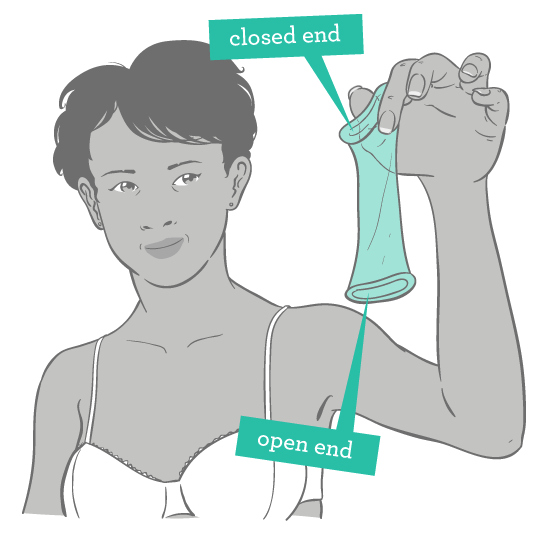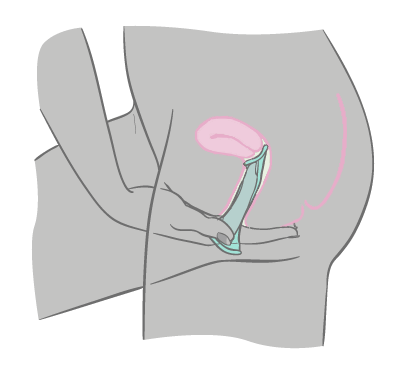- Birth control
- Internal condom (FC2)
Internal condom (FC2)

What is the internal condom (FC2)?
The internal condom (sold under the brand name FC2) is a pouch that feels and works a lot like the external condom, which is usually just referred to as a “condom.” Internal condoms are a type of barrier method of birth control, which means that they prevent pregnancy by physically blocking sperm from getting to eggs.
Internal condoms are bigger than external condoms, since they’re designed to sit inside the vagina, with part that stays on the outside. When ejaculation happens, the semen (the whitish fluid that comes out of the penis and contains the sperm) stays inside the internal condom and out of direct contact with the vagina. This keeps sperm away from any eggs. Internal condoms can each only be used one time, just like external condoms. Internal and external condoms are the only birth control methods that can also protect against STIs.
The biggest difference between the internal and external condom is that the internal condom sits inside the vagina while the external condom fits snugly over the penis. Also, internal condoms are not as easy to get as external condoms. You have to see a provider to get a prescription for internal condoms.
Internal condoms are also used by some people for anal sex, both to help prevent STI transmission and to make things as mess-free as possible.
Quick Facts
-
Effectiveness
Internal condoms are pretty effective the way most people use them.
Perfect use: 95% effective
Typical use: 79% effective
What are perfect use and typical use?
-
Hormones
Internal condoms are hormone-free.
-
Side effects
If you’re sensitive, they could cause a little irritation. They may reduce sensation slightly when you’re having sex.
-
Cost
As low as $0 (with insurance) or as high as $3 per internal condom.
-
STI protection
Internal condoms can offer STI protection as well as pregnancy prevention.
-
Ongoing effort
You have to make sure to use internal condoms correctly every time in order for them to be effective at preventing pregnancy and STIs.
The internal condom might be right for you if…
You want birth control without hormones.
If you are looking for pregnancy prevention but don’t want to use hormones, internal condoms may be a good option for you.
You’re willing to put in some effort before having sex, every single time.
You have to make sure to use internal condoms correctly, every time, no matter what, in order for them to be effective at preventing pregnancy and STIs.
If you do use them perfectly (exactly how the instructions say to use them) every single time you have penis-in-vagina sex, internal condoms are pretty effective. With perfect use, internal condoms are 95% effective, which means that, on average, five out of every 100 people using internal condoms perfectly for a year will get pregnant.
The problem is that most people have trouble using internal condoms perfectly every time they have sex. The effectiveness of internal condoms with typical use, which means how real people use them in real life, is more relevant for most people than their effectiveness with perfect use. With typical use, internal condoms are 79% effective at preventing pregnancy. That means that, on average, 21 out of every 100 people using internal condoms for a year will get pregnant. (And of course, if you don’t use an internal condom at all when you have sex, then it’s 0% effective at preventing pregnancy.)
Because internal condoms are hard to use perfectly every time, and because their effectiveness is so much lower when they’re not used perfectly every time, internal condoms are not considered one of the most effective methods of birth control out there.
Internal condoms can also be used with other birth control methods to reduce the chances of pregnancy. The only methods internal condoms can’t be used with are those that go into the vagina, which include external condoms, the diaphragm, the cervical cap, and the ring).
You want protection from STIs.
Internal condoms help protect you and your partner from most sexually transmitted infections (STIs), including HIV. One advantage of internal condoms over external condoms is that they can cover some of the external genitalia (the vulva) because they have a part that stays outside the body. This lowers the risk of STIs that are passed along by skin-to-skin contact, like herpes, syphilis, and HPV.
You don’t need to hide your method.
It’s not easy to hide that you’re using internal condoms. While you may be able to hide them from people you live with, internal condoms do have to be thrown in the trash along with their wrappers after you use them, so if people you live with can see or access your trash, they may find out you’re using internal condoms.
Sexual partners with a penis will probably be able to see and/or feel that you are using an internal condom.
You want a method that won’t affect your future fertility.
The only birth control method that permanently affects your fertility is sterilization. The internal condom does not affect your ability to get pregnant after you or your partner remove it. That’s why you have to use an internal condom every time you have sex—they don’t give you any lasting protection against pregnancy. (And don’t forget each internal condom can only be used one time.)
You want a method that you can stop without help from a provider.
You’ll need to get a prescription to get internal condoms, but you don’t need to see a provider to stop using them—you can just stop whenever you want. Just remember that you’ll need to start using another method of birth control right away if you don’t want to become pregnant.
You’re in between methods or made a mistake with your usual method.
Internal condoms are great in a pinch. If you can’t make it to the pharmacy for your birth control refill, or you realize you’ve missed a pill (or missed a step with another form of hormonal birth control), you can always use an internal condom. However, you need a prescription to get internal condoms, so it’s a good idea to get some now to have on hand if you need them in the future.
For mistakes with hormonal birth control methods, as well as when you start on a hormonal birth control method, you may need to use internal condoms, condoms, or another backup form of birth control for 7 days, so check with a provider or read the instructions that came with your hormonal method to find out.
You may also want to use emergency contraception if you make a mistake with your birth control and then have unprotected sex.
You need a latex-free option.
Internal condoms are made of nitrile (a synthetic rubber), so you can use them if you or your partner(s) are allergic to latex. Because they’re made of nitrile, one perk of internal condoms is that you can use oil-based lubricants with them, unlike with other kinds of condoms. So if you’ve been wanting to try coconut oil as lube, the internal condom may be just the thing for you.
External condoms aren’t working for you and/or your partner.
If using an external condom just isn’t working for you or your partner, but you still want protection against STIs, the internal condom is the way to go.
How do you use internal condoms?
Internal condoms may take a bit of practice to use, but once you know how to do it, they’re actually pretty easy to use.

How to insert an internal condom:
- Open the package. You’ll see what looks like a thin, tube-shaped bag, with an opening on one end and a flexible ring on the other end, which is closed.
- Add lube to the outside of the internal condom if you want, to make inserting it easier. You could also put some spermicide on the closed end as well if you want extra protection from pregnancy. Adding lube inside the internal condom too can make sex more pleasurable for the person with a penis, and it can also help prevent the condom from breaking.
- Get comfy, like you’re going to put in a tampon or menstrual cup.
- Put your index and/or middle finger into your vagina and feel for your cervix, so you’ll know how far in to push the closed-end ring. Your cervix will feel sort of hard but squishy, like the tip of your nose.

- Squeeze the sides of the closed-end ring together.
- Insert it into your vagina like you would a menstrual cup or tampon with no applicator. Push the closed-end ring as far into your vagina as it’ll go, all the way up to your cervix. Some people place the internal condom over a dildo or penis and put it in place by inserting the toy or penis, but it can be harder to tell if it’s placed correctly if you do it this way.
- Pull out your finger and let the open end of the internal condom hang about an inch outside your vagina. The outer ring helps keep the internal condom in place and helps protect you from STIs that are transferred through skin-to-skin contact by covering part of your vulva.
Some tips for using internal condoms:
- Don’t use an internal condom and an external condom at the same time. You might think using both would double your protection, but it will actually make it more likely that both will tear. So just pick one to use every time you have sex.
- Use one internal condom per ejaculation. You will need a brand new one if you want to keep having penis-in-vagina sex after the person with a penis ejaculates. Never rinse out an internal condom and reuse it—this can make it not work as well.
- Put in a new internal condom if you switch between types of sex, even if the person with a penis hasn’t ejaculated. That means that you will need a new condom if you are switching from anal to vaginal sex or from vaginal to anal sex.
- Make sure to hold the outside part of the internal condom open when you’re inserting a penis or a toy. That will keep it from getting pushed inside the vagina entirely. Don’t worry if it moves side to side while you’re having sex. That’s normal. But if your partner slips out of the condom and into your vagina, stop sex, remove the internal condom, and insert a new one. But if they ejaculate outside of the internal condom and into your vagina by accident, you may want to consider emergency contraception.
- If you’re using an internal condom for anal sex, the steps are basically the same. The only difference is that some people like to remove the ring from inside the closed end of the condom to make it more comfortable.
How to remove an internal condom:
- Hold the outer ring and twist the part of the internal condom that is outside of your body closed like a baggie, so semen doesn’t spill out.
- Pull the condom out gently.
- Throw it away in a trash can (preferably one that is out of the reach of children and pets). Don’t flush it down the toilet.
- Make sure the partner with a penis washes their penis with soap and water if it’s going to come into contact with the vulva again.
How much do internal condoms cost?
With insurance
Because the internal condom is a prescription birth control method, if you have health insurance—whether it’s from work, school, your parents, or Medicaid— chances are good that you’ll be able to get it without having to pay anything out of pocket.
Without insurance
If you don’t have insurance or if you’re on a plan that doesn’t cover internal condoms, they cost between $2 and $3 per condom, and they usually come in packs of 12 or 24.
If you need help covering the cost of the internal condom, there may be options. Check with local clinics, health departments, and nonprofits to find out if they offer free internal condoms and other kinds of birth control (most do). FC2, the company that makes the internal condom, also has a program that offers reduced price internal condoms to those who qualify.
What are the side effects and benefits of internal condoms?
Every birth control method has pros and cons—and everyone’s experience is different.
The Positive
There are lots of things about birth control that are good for your body as well as your sex life. Here are some of the benefits of the internal condom:
- They help protect you from STIs.
- The outer ring may stimulate the clit of the person with a vagina.
- They can be used even if you’re allergic to latex.
- They can be used with oil-based lube (as well as water-based and silicone-based lube).
- They stay in place even if your partner loses their erection, unlike external condoms.
- Because internal condoms require a prescription, insurance may cover the cost.
The Negative
Internal condoms may cause irritation for some people who are sensitive. In addition to this possible side effect, there are some disadvantages:
- They can be little tricky to get the hang of.
- They may reduce sensitivity while you’re having sex.
- You have to remember to use one every time you have sex.
- They’re not as easy to get as external condoms because you need a prescription.
Where can you get internal condoms?
You can visit a health care provider in person or via telehealth to get a prescription for internal condoms, and then you can pick up your prescription at a local pharmacy or have it mailed to you. You can also get them through the FC2 website, which offers a telehealth service to provide you with a prescription and ship the internal condoms to you. Some nonprofits and health centers will provide them for free.
FC2 is the only FDA-approved internal condom in the U.S.. You may find other brands of internal condoms online, but they are not FDA-approved so we don’t know how well they work to prevent pregnancy or STIs.

We can help you find an in person provider or online birth control delivery service.
find health care